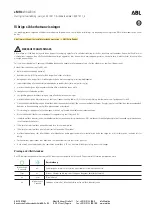
NOTE:
Installing accessories that are not approved by
Tesla can interfere with the TPMS.
WARNING:
The TPMS is not a substitute for proper
tire maintenance, including manually checking tire
pressures and regularly inspecting the condition of
tires. It is the driver's responsibility to maintain
correct tire pressure, even if under- or over-
inflation has not reached the level for the TPMS to
trigger the Tire Pressure Warning on the
touchscreen.
Automatic Reset of TPMS Sensors
After replacing one or more wheels (but not after
replacing a tire), the TPMS sensors are relearned to
ensure tire pressure warnings are accurate. TPMS
sensors reset automatically within 10 minutes of driving
over 15 mph (25 km/h).
WARNING:
If your Model 3 is equipped with
aftermarket tires that differ in size from those
printed on the Tire and Loadingand Loading
Information Label (see
), it is the driver's responsibility to determine
the correct tire pressure. Do not drive on public
roads when tires are not inflated to the correct
pressure.
WARNING:
Do not depend on TPMS sensors to
accurately determine pressures and trigger alerts.
It is the driver's responsibility to maintain correct
tire pressures (see
). Over or under-inflated tires can result in
loss of control or tire damage, which can lead to
serious injury.
Replacing a Tire Sensor
If the Tire Pressure warning indicator displays frequently,
contact Tesla to determine if a tire sensor needs to be
replaced. If a non-Tesla Service Center repairs or
replaces a tire, the tire sensor may not work until Tesla
performs the setup procedure.
TPMS Malfunction
Model 3 has also been equipped with a TPMS
malfunction indicator to indicate when the system is not
operating properly.
The TPMS malfunction indicator is
combined with the tire pressure indicator
light. When the system detects a
malfunction, the indicator flashes for
approximately one minute, then remains
continuously lit. This sequence continues
upon subsequent vehicle start-ups as long
as the malfunction exists. When the TPMS
malfunction indicator is on, the system
might not be able to detect or signal
under- or over-inflated tires as intended.
TPMS malfunctions can occur for a variety of reasons,
including installing replacement or alternate tires or
wheels that prevent the TPMS from functioning properly.
Always check the TPMS malfunction indicator light after
replacing one or more tires or wheels on your vehicle to
ensure that the replacement tires or wheels allow the
TPMS to continue to function properly.
NOTE:
If a tire has been replaced or repaired using a
different tire sealant than the one available from Tesla,
and a low tire pressure is detected, it is possible that the
tire sensor has been damaged. Contact Tesla to have the
fault repaired as soon as possible.
Seasonal Tire Types
Understand Your Tire Type
The type of tires that your vehicle is originally equipped
with depends on vehicle model and market region. It is
important to understand the capabilities of your
vehicle's tires and whether they are suited for summer,
all-season, or winter driving. Check the information on
the sidewall of a tire for information about a tire's
performance characteristics (see
Summer and All-Season Tires
Summer tires and all season tires are designed for
maximum dry and wet road performance but are not
designed to perform well in winter conditions. All-
season tires are designed to provide adequate traction
in most conditions year-round, but may not provide the
same level of traction as winter tires in snowy or icy
conditions. All-season tires can be identified by “ALL
SEASON" and/or "M+S” (mud and snow) on the tire
sidewall.
If driving in cold temperatures or on roads where snow
or ice may be present, Tesla recommends using winter
tires. If not equipped with winter tires, contact Tesla for
winter tire recommendations.
WARNING:
In cold temperatures or on snow or ice,
summer and all-season tires do not provide
adequate traction. Selecting and installing the
appropriate tires for winter conditions is important
to ensure the safety and optimum performance of
your Model 3.
Winter Tires
Use winter tires to increase traction in snowy or icy
conditions. When installing winter tires, always install a
complete set of four tires at the same time. Winter tires
must be the same diameter, brand, construction and
tread pattern on all four wheels. Contact Tesla for winter
tire recommendations.
Tire Care and Maintenance
173
Maintenance
Содержание 3 2022
Страница 1: ...MODEL 3 OWNER S MANUAL Software version 2022 16 North America...
Страница 48: ...Steering Wheel 46 MODEL 3 Owner s Manual...
Страница 50: ...Mirrors 48 MODEL 3 Owner s Manual...
Страница 266: ...Publication date 2022 5 1...
















































